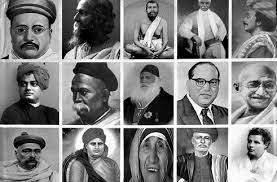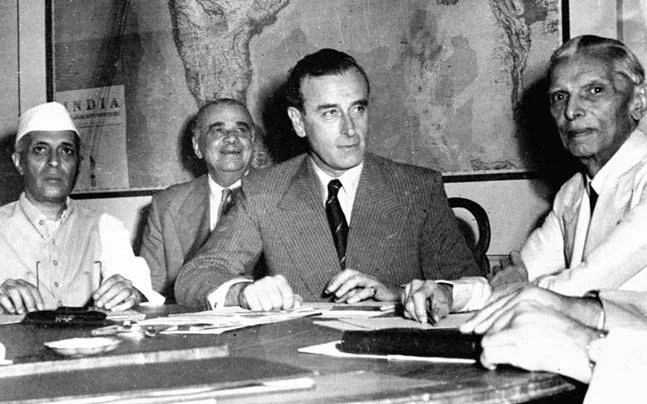- Courses
- GS Full Course 1 Year
- GS Full Course 2 Year
- GS Full Course 3 Year
- GS Full Course Till Selection
- Answer Alpha: Mains 2025 Mentorship
- MEP (Mains Enrichment Programme) Data, Facts
- Essay Target – 150+ Marks
- Online Program
- GS Recorded Course
- Polity
- Geography
- Economy
- Ancient, Medieval and Art & Culture AMAC
- Modern India, Post Independence & World History
- Environment
- Governance
- Science & Technology
- International Relations and Internal Security
- Disaster Management
- Ethics
- NCERT Current Affairs
- Indian Society and Social Issue
- NCERT- Science and Technology
- NCERT - Geography
- NCERT - Ancient History
- NCERT- World History
- NCERT Modern History
- CSAT
- 5 LAYERED ARJUNA Mentorship
- Public Administration Optional
- ABOUT US
- OUR TOPPERS
- TEST SERIES
- FREE STUDY MATERIAL
- VIDEOS
- CONTACT US
Mahavir Jayanti 2025: The Relevance of Jaina Philosophy in Today’s Times and for UPSC Aspirants
Mahavir Jayanti 2025: The Relevance of Jaina Philosophy in Today’s Times and for UPSC Aspirants
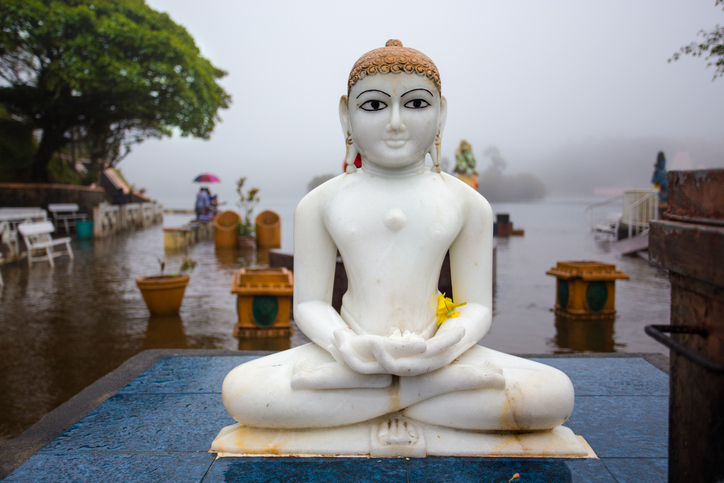
Mahavir Jayanti, also known as Mahaveer Janma Kalyanak, is one of the most significant festivals in Jainism, celebrated to honor the birth anniversary of Lord Mahavira, the 24th and last Tirthankara of the Jaina tradition.
In 2025, the occasion marks the 2623rd birth anniversary of the revered spiritual teacher and reformer, observed on 10th April.
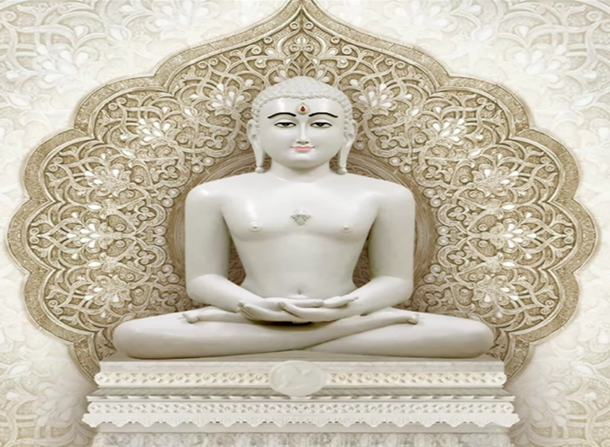
Lord Mahavira in lotus posture depicted in Svetambar iconography.
Born in 540 BCE in Kundalagrama, a suburb of Vaishali in modern-day Bihar, to King Siddhartha and Queen Trishala, Mahavira belonged to the Ikshvaku dynasty. His mother, Trishala, was notably the sister of the Licchavi chief Chetaka, establishing Mahavira’s close connection with the Licchavi republic.
At the age of 30, he renounced his princely life, gave up all worldly pleasures, and embarked on a path of spiritual awakening, spending 12 years as an ascetic in deep meditation and penance.
The Philosophy of Lord Mahavira and Its Contemporary Significance
Mahavira’s teachings, spread over 30 years of travel across India, centered around five foundational ethical principles that remain timeless in their moral and philosophical depth. These include:
- Ahimsa (non-violence)
- Satya (truth)
- Asteya (non-stealing)
- Brahmacharya (chastity)
- Aparigraha (non-possession)
|
Note: - These principles form the core ethical foundation of Jainism and are not only relevant to spiritual seekers but also deeply significant for aspirants preparing for competitive exams like UPSC, which requires an understanding of India’s philosophical diversity, ethical frameworks, and cultural heritage. |
Jaina Doctrine: Anekantavada and Syadavada
What sets Jain philosophy apart is its profound acceptance of the complex and multifaceted nature of truth and reality. The doctrine of Anekantavada emphasizes the idea that truth and reality are perceived differently from diverse points of view, and no single perspective holds the complete truth. This idea is complemented by Syadavada, or the "doctrine of maybe," which advocates a conditional approach to truth, fostering intellectual humility and openness.
According to Jain metaphysics, every existing entity has three fundamental aspects:
- Substance (dravya)
- Quality (guna)
- Mode (paryaya)
|
Note:- Such a detailed ontological framework promotes a holistic understanding of existence, aligning with the interdisciplinary thinking required in the UPSC civil services examination, especially in ethics, philosophy, and general studies. |
The Jaina Concept of the Soul (Jiva)
Jainism upholds a unique metaphysical view of the soul. It believes that all souls are inherently equal and possess four infinite attributes, collectively known as Anantacatustaya:
- Infinite knowledge
- Infinite perception (faith)
- Infinite bliss
- Infinite energy
Unlike other traditions, Jainism asserts that the accumulation of karma is what hinders these natural qualities from manifesting. It is particularly noteworthy that even unintentional acts can generate karma. This deep ethical concern led to strict occupational codes for Jains, where professions involving harm to living beings—such as agriculture, animal transport, and trades involving animal by-products—were discouraged or even prohibited.
The Triratna and the Five Great Vows
Jainism prescribes a path of liberation known as the Triratna (Three Jewels):
- Right Faith (Samyag-darshana)
- Right Knowledge (Samyag-jnana)
- Right Conduct (Samyag-charitra)
These are reinforced by the Panchamahavrata (Five Great Vows) that Jain monks and nuns are expected to follow:
- Satya – speaking the truth
- Ahimsa – non-violence in thought, speech, and action
- Asteya (Achaurya) – not stealing
- Aparigraha – renunciation of possessions
- Brahmacharya – celibacy or control over desires
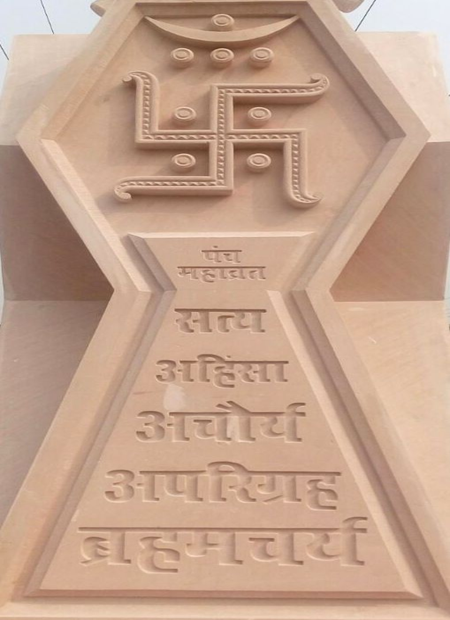
Jain emblem and the "Five Vows"
These vows are not only spiritually transformative but are also intellectually engaging for candidates of civil services, especially in ethics and integrity case studies.
A striking example of the Jain spiritual outlook is reflected in a verse by Jain monk Pujyapada (4th century CE):
“Death is not for me. Why then should I fear?
Disease is not for me. Why then should I despair?
I am not a child, nor a youth, nor an old man—
All these states are only of my body.”
Government’s Initiative: The Tirthankar Circuit
Recognizing the spiritual and cultural richness of Jainism, the Government of India, under the Swadesh Darshan Scheme (2015), has launched the development of a Tirthankar Circuit in Bihar. The circuit includes:
- Vaishali
- Arrah
- Masad
- Patna
- Rajgir
- Pawapuri
- Champapuri
This initiative aims to promote religious tourism and preserve the Jain heritage for future generations.
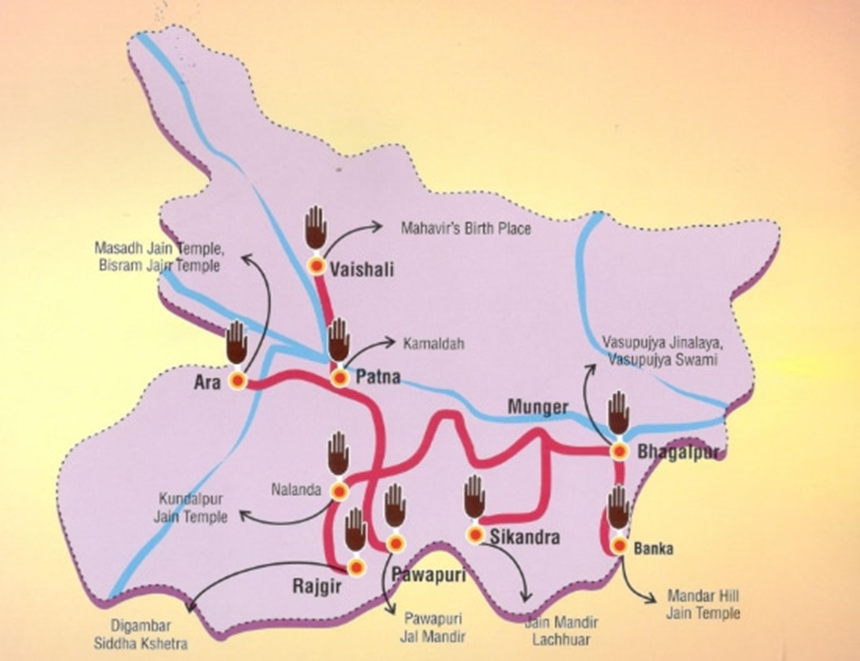
Tirthankar circuit
Jain Sects: Digambara and Shvetambara
As Jainism evolved, it witnessed a significant division around 300 CE, forming two major sects—Digambara (sky-clad) and Shvetambara (white-clad). According to Upinder Singh, this schism occurred following a severe famine during the reign of Chandragupta Maurya, which forced a group of Jain monks led by Bhadrabahu to migrate to the Deccan. Upon returning, they found that monks in the north, led by Sthulabhadra, had started wearing white robes, marking the beginning of the two major sects.
The Digambara sect insists on complete nudity as a symbol of renunciation and maintains that women must be reborn as men to attain liberation. The Shvetambaras, however, allow the possibility of female salvation and adopt a more symbolic approach to renunciation.
Jaina Literature and Language
The early Jaina scriptures, known as Agamas or Siddhantas, were written in Ardha-Magadhi, the language spoken by Mahavira himself. The Shvetambara canon includes:
- 12 Angas
- Upangas
- Prakirnas
- Cheda Sutras
- Mula Sutras
The Angas were first compiled at a council held in Pataliputra, and the complete canon was compiled in the 5th or 6th century CE at Valabhi in Gujarat, presided over by Devarddhi Kshamashramana.
Jain literature is rich in narrative and historical depth. The Adi Purana (9th century) narrates the life of Rishabha, the first Tirthankara. The Harivamsha Purana (8th century) offers a Jaina perspective on the Mahabharata characters. Hemachandra’s Parishishtaparvan (12th century) provides valuable insights into the early history of Jain teachers and medieval political developments.
Conclusion: Why Jaina Philosophy Matters for UPSC Aspirants
For aspirants of the UPSC Civil Services Examination, understanding Jain philosophy is crucial not just for ancient Indian history and culture, but also for ethics, moral philosophy, and religious diversity in India. Its profound insights into non-violence, truth, and detachment offer timeless lessons, especially relevant in today’s world of material excess and social conflict.
Celebrating Mahavir Jayanti is not just about remembering a historical figure but about reconnecting with the values that can guide individual conduct and public service alike.
|
Also Read |
|



